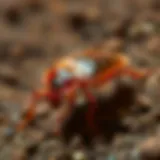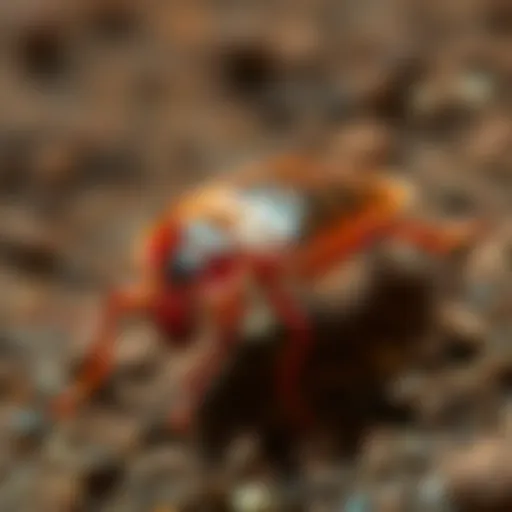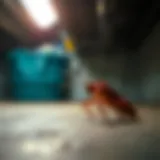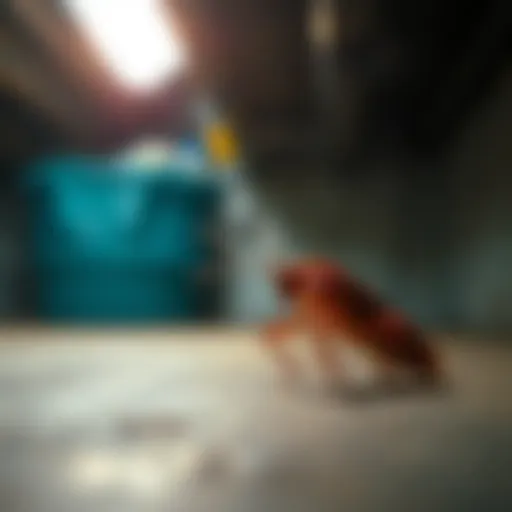A&C Pest Control: Effective Strategies for Homeowners


Intro
Pest control is a crucial topic for many homeowners and gardeners. It involves understanding various methods and technologies for managing unwanted organisms that can cause damage to property or affect health. This narrative focuses on A&C Pest Control, exploring their innovative practices and solutions that prioritize efficiency and sustainability.
Understanding Pests
Definition of Pests
Pests are organisms that are typically considered undesirable in a specific context, such as in homes, gardens, or agricultural settings. They often include insects, rodents, and other animals that can cause harm or nuisance. Understanding what constitutes a pest is the first step in effective management.
Importance of Pest Identification
Identifying pests accurately is essential for anyone interested in pest control. An incorrect identification can lead to ineffective treatments. Furthermore, proper identification helps in choosing the most suitable and eco-friendly control methods. Homeowners must be aware of the common pests in their area, such as ants, bedbugs, or rodents, and how to recognize their signs.
"Effective pest management starts with knowing what you're dealing with. Accurate identification is key."
Prevention Techniques
Home and Garden Preventative Measures
Preventative measures are the first line of defense against pest invasions. In homes, sealing cracks and gaps can prevent entry. Using screens on windows and doors is another useful tactic. In gardens, regularly inspecting plants and removing debris can deter pests. It is often easier to prevent pests than to control them after they have established a presence.
Seasonal Prevention Tips
Different seasons present unique challenges for pest control. In the spring, for example, homeowners should be vigilant for emerging pests like termites. Fall is the time when rodents seek shelter indoors. Thus, it is crucial to adjust your prevention tactics accordingly.
- Spring: Inspect for termites and other wood-destroying insects.
- Summer: Monitor for wasps and bees, especially during outdoor events.
- Fall: Close entry points to prevent mice from entering.
- Winter: Keep food stored properly to avoid attracting pests.
Eco-Friendly Pest Control Solutions
Overview of Sustainable Practices
The demand for eco-friendly pest control has risen significantly. Sustainable practices aim to minimize harm to non-target species, humans, and the environment. These methods often include Integrated Pest Management (IPM), which combines various techniques for the most effective outcome.
Natural Remedies and Their Effectiveness
Many natural remedies can be effective for controlling pests. These include:
- Diatomaceous earth for insects.
- Essential oils like peppermint or tea tree as repellents.
- Soap sprays to target specific pests without harming beneficial insects.
Each of these solution types has its strengths, and they can be integrated into a broader pest management strategy. Understanding the effectiveness of these remedies helps inform decisions about pest control.
In closing, A&C Pest Control emphasizes understanding, prevention, and eco-friendly solutions. Through careful exploration of methodologies and active management, homeowners can maintain healthier environments, minimizing the impact of pests.
Understanding A& Pest Control
Understanding A&C Pest Control is crucial for homeowners and individuals who wish to manage pest issues effectively and sustainably. This knowledge not only alleviates current problems but also empowers individuals to prevent future infestations. In this exploration, we focus on various elements that contribute to comprehensive pest control, including identification, prevention, and innovative solutions. A deeper understanding of these topics helps in minimizing the health risks posed by pests and reducing reliance on harmful chemicals that may interfere with ecosystems.
Defining A& Pest Control
A&C Pest Control refers to a specific approach aimed at effectively managing pest populations while considering environmental impacts. This method incorporates various strategies that target not just the pest, but also the conditions that promote their survival. This approach emphasizes sustainable practices which include monitoring, maintaining a clean environment, and using interventions that pose minimum risk to beneficial organisms. This definition lays the groundwork for the subsequent discussion on historical applications and modern advances in pest management.
Historical Background
Historically, pest control has evolved dramatically. In ancient societies, people relied on manual methods such as trapping and removal. As agriculture developed, the need for more sophisticated methods increased. The introduction of pesticides in the 19th century marked a significant shift, but it also caused concern regarding environmental and health impacts.
In the late 20th century, awareness regarding chemical pesticides' effects led to the emergence of integrated pest management (IPM). IPM combines biological, cultural, physical, and chemical tools in a way that minimizes risks. This historical context underscores the importance of understanding the evolution of pest control techniques. It allows current management strategies to build upon past lessons, emphasizing the significance of environmental consciousness today.
Common Pests: Identification and Behavior
Understanding common pests is crucial for anyone looking to manage their domestic environment effectively. Pests not only cause physical damage to property but can also pose health risks to residents if left unchecked. Identifying these pests accurately is the first step in addressing any pest-related issues. Knowing their specific behaviors helps in developing a targeted approach to control and prevention. This section will delve into the classifications of household pests, particularly focusing on rodents, insects, and termites, and their respective behavioral patterns.
Types of Household Pests
Rodents
Rodents such as mice and rats are prolific breeders and known for their adaptability. They can enter homes through tiny openings and quickly become established. Their key characteristic is the ability to gnaw through various materials, which can lead to significant property damage. This makes understanding rodent behavior indispensable in pest control. Rodents are often seen as a popular concern in pest management because they can contaminate food supplies and spread diseases. The unique feature of rodents is their high reproductive rate, posing a challenge in controlling their population. The advantage of discussing rodents in this article is their ubiquity and the immediate threat they often represent to homeowners.
Insects
Insects encompass a vast array of species that invade homes, including ants, cockroaches, and bedbugs. Their key characteristic lies in their diverse behavior patterns and habitats. Insects can often go unnoticed until their population has grown extensively, which underscores their importance in pest control discussions. Being a common and widespread issue, insects represent a beneficial topic for homeowners who seek immediate solutions. A unique feature of insects is their ability to adapt and overcome many control methods, which can present a disadvantage in managing their control. Focusing on insects in this article informs readers of potential infestations that could develop in their homes.
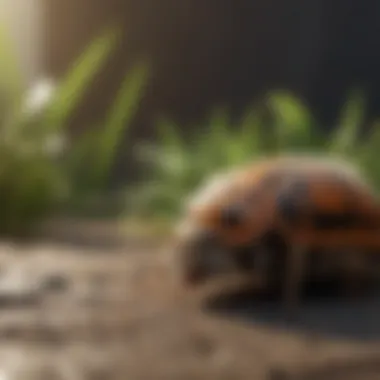

Termites
Termites are particularly notorious for their destructive abilities, especially regarding wooden structures. Their main key characteristic is their consumption of cellulose, which can lead to severe structural damage over time. Understanding termite behavior is essential as they can often go undetected until extensive damage is done. They are a beneficial group to highlight because of their significant impact on home safety. The unique feature of termites is their colonies' organized social structure, which can lead to rapid damaging activities. By addressing termites in this article, homeowners can gain insights into prevention and detection methods vital for maintaining their property’s integrity.
Behavioral Patterns
The behavior of pests is a critical factor in effective pest management. Understanding how pests operate, feed, and reproduce can inform better control strategies. For instance, many pests are nocturnal, meaning they are active during the night, which complicates detection and control efforts. Identifying behavioral patterns helps determine the most effective prevention and treatment methods, ensuring homeowners can protect their living spaces proactively. Studying pest behaviors also aids in uncovering environmental triggers that might attract pests, guiding the focus towards long-term management strategies.
Identifying and understanding the behavior of common pests is essential for effective pest management. This base knowledge empowers homeowners to implement timely and targeted control measures.
Effective Prevention Techniques
Effective prevention techniques in pest control are crucial for maintaining a healthy environment in homes and gardens. These methods not only minimize pest infestations but also reduce the need for chemical treatments, making them more sustainable. Prevention strategies can evolve based on the specific pest issues faced by homeowners, thus requiring a tailored approach.
Environmental Control Measures
Environmental control measures focus on modifying the habitat to make it less conducive to pest infestations. One effective way to achieve this is through proper sanitation. Keeping living spaces and outdoor areas clean can significantly decrease the likelihood of pests, such as cockroaches and ants, finding food sources. Regular sweeping, vacuuming, and the proper disposal of waste will help deter these unwanted visitors.
Another essential measure is managing water sources. Pests, particularly mosquitoes, are drawn to stagnant water. Homeowners should routinely empty or treat bird baths, clogged gutters, and plant pots to avoid creating breeding grounds. This can substantially lessen the population of pests that may invade living spaces.
In addition, landscaping plays a vital role in pest management. Choosing native plants tends to attract natural predators of common pests. For instance, planting marigolds can help repel nematodes and insects that attack vegetable gardens. The integration of such plants into a garden can establish a natural balance, reducing the reliance on chemical solutions.
Physical Barriers
Physical barriers serve as a direct method to prevent pests from entering homes. Sealing gaps and cracks in walls, windows, and doors is one effective approach. Use caulk to fill small openings, and install weather stripping on doors and windows to ensure a tight seal. Doing so will not only help keep pests out but can also improve energy efficiency.
Installing screens on windows and doors also provides protection against insect entry while allowing airflow. Additionally, mesh barriers can be used in gardens to protect tender plants from larger pests like rabbits or deer.
Creating barriers with specific materials can also be useful. For example, copper tape can deter slugs and snails, while using landscaping fabric can prevent weeds and pests from taking root in gardens. These strategies effectively combine practicality with sustainability, as they minimize the need for pesticide applications.
"Investment in prevention techniques not only promotes sustainability but also enhances the quality of life at home."
Incorporating effective prevention techniques into daily routine is crucial for any homeowner. By focusing on environmental control measures and physical barriers, it is possible to create a proactive approach to pest management. This not only helps in keeping the home pest-free but also fosters a more sustainable living environment.
Eco-Friendly Pest Control Solutions
The increasing awareness of environmental issues has significantly influenced pest management practices. Eco-friendly pest control solutions focus on methods that minimize harm to the ecosystem while effectively managing pest populations. These practices are not only beneficial for the environment but also promote the health and safety of homes and gardens. Homeowners are becoming more discerning about the products they use, seeking alternatives that are less toxic and more sustainable.
Natural Remedies
Natural remedies serve as an essential component of eco-friendly pest control. These solutions often utilize common household items and natural substances. For instance, products such as vinegar, baking soda, and essential oils can deter various pests without the need for harsh chemicals.
- Vinegar: Effective against ants and fruit flies. Mixing vinegar with water creates a powerful cleaning solution that leaves little trace of food odors that attract these pests.
- Baking Soda: A versatile ingredient capable of tackling issues with cockroaches. When mixed with sugar, it draws pests for consumption, leading to their demise through dehydration.
- Essential Oils: Oils like peppermint, tea tree, and lavender serve as natural repellents for spiders and other insects. These oils can be mixed with water and sprayed around entry points to keep bugs at bay.
Natural remedies not only provide effective pest control but are also safe for families and pets. By opting for these solutions, homeowners contribute to a greener planet while protecting their living spaces.
Biological Control Agents
Biological control agents represent another innovative aspect of eco-friendly pest management. This approach involves introducing natural predators or parasites to control pest populations. This strategy minimizes the need for chemical pesticides while ensuring a balance in the ecosystem.
- Ladybugs: Known for their effectiveness in controlling aphid populations. Introducing ladybugs into a garden provides a ready-made solution for aphid infestations, reducing the need for pesticides.
- Parasitic Wasps: These tiny insects target specific pest species like caterpillars or whiteflies. By laying their eggs in or on these pests, parasitic wasps help to regulate their numbers naturally.
- Nematodes: Microscopic worms that combat soil-dwelling pests such as grubs and root weevils. They infiltrate the pest's body, leading to its death without affecting plants or beneficial organisms.
Utilizing biological control agents ensures that pest management aligns with sustainable practices. This method not only safeguards crops and plants but also preserves the natural balance of the environment.
"The shift towards eco-friendly pest control solutions highlights a growing commitment to protecting ecosystems while maintaining effective pest management."
In summary, adopting eco-friendly pest control solutions is a fundamental choice for informed homeowners who wish to manage pests responsibly. The effectiveness of natural remedies and biological control agents enhances pest management while promoting an environmentally-conscious approach.
The Role of Technology in Pest Management
Technology is reshaping the landscape of pest control in notable ways. With ongoing advancements, the integration of tech into pest management is becoming essential. This section highlights the significance of innovative technological approaches in understanding and managing pest populations effectively.
Modern pest management systems leverage various tools that not only improve efficiency but also enhance sustainability. Benefits include the reduction of chemical use, improved accuracy in targeting pests, and better monitoring capacities. Reliance on technology allows for more informed decision-making when it comes to pest control strategies, ultimately leading to healthier environments and minimized risks for human health.
Innovations in Detection
Accurate detection of pests is a prerequisite for effective pest management. Recent technological innovations have shifted traditional methods of identifying pest presence toward more advanced solutions. Sensors and smart traps provide real-time data on pest activity. These devices are designed to monitor fluctuations in pest populations and to alert homeowners or professionals when intervention is necessary.
Unmanned aerial vehicles, or drones, also play a role in pest detection, particularly in large agricultural settings. They can survey vast land areas quickly. This technology can identify potential pest problems before they escalate, enabling preemptive action.
The following points illustrate key innovations in detection:
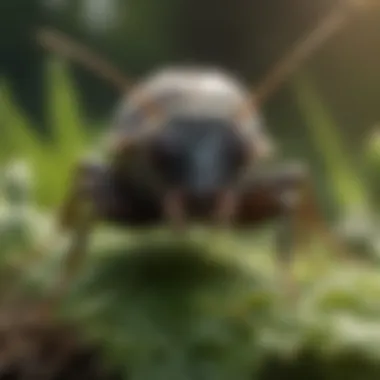

- Smart traps that alert users to captures, reducing the need for frequent site visits.
- Remote monitoring systems that track pest movements via sensors.
- Drones that provide aerial imagery to assess crop health and pest infestation.
"The integration of technology in pest detection allows for a proactive approach, ensuring problems are addressed before they become widespread."
Automated Solutions
Automated solutions are further enhancing pest control methods. Robotic systems and automated sprayers are increasingly utilized for efficient pesticide application. These automated systems reduce human error and ensure that only targeted areas receive treatments, thus minimizing the environmental impact.
Moreover, algorithms and artificial intelligence are being used to predict pest outbreaks based on climatic conditions, historical data, and current infestations. Such capabilities allow homeowners and pest control professionals to act swiftly and effectively, optimizing resource allocation and fostering sustainable practices.
Among the advantages of automated solutions are:
- Precision application that minimizes chemical runoff.
- Reduction in labor costs, enabling more efficient use of human resources.
- Real-time data analysis for responsive pest management strategies.
In summary, the role of technology in pest management is growing. From innovations in detection to automated solutions, these advancements present opportunities to improve the efficacy of pest control measures while also promoting sustainable practices.
Understanding Pest Behavior and Ecology
Understanding pest behavior and ecology is crucial for effective pest management. Pests are not only nuisances but also play roles in the environment. Recognizing their behaviors and ecological impact helps in formulating better control strategies. This knowledge allows homeowners to anticipate pest activities and address potential infestations proactively, reducing reliance on chemical treatments.
The study of pest behavior includes their reproductive cycles, feeding habits, and interaction with other species. For instance, understanding when rodents breed can enable homeowners to implement preventive measures before a population explosion occurs. Additionally, recognizing pest habitats allows for targeted interventions that can disrupt their environment without affecting non-target species.
Another important aspect is how pests can affect local ecosystems. Certain pest species may act as vectors for diseases or disrupt food chains. When homeowners grasp these ecological functions, they can appreciate the importance of balanced pest management. This holistic approach can lead to more sustainable pest control measures overall.
Ecological Impact of Pests
The ecological impact of pests can be significant. They can affect human health, agriculture, and wildlife. For instance, some pests are carriers of diseases, posing risks to humans and pets. Understanding these risks is essential for effective pest control.
In agriculture, pests can devastate crops. Issues such as aphids or locusts can lead to significant economic losses. However, not all pests are harmful; some play roles in pollination. Recognizing beneficial pests is key. Homeowners should focus on integrated pest management strategies that protect beneficial species while controlling harmful ones.
Some pests also contribute to soil health. For example, earthworms improve soil structure, while other insects help decompose organic matter. This creates a cycle that benefits gardens and ecosystems.
"It is important to balance the control of harmful pests while understanding the bigger picture of pests in the ecosystem."
To mitigate negative impacts, homeowners can implement strategies such as:
- Encouraging birds and beneficial insects that prey on harmful pests.
- Rotating crops to disrupt pest lifecycles.
- Maintaining biodiversity, which fosters natural pest control mechanisms.
Overall, recognizing both the harmful and beneficial aspects of pests plays an important role in creating effective control strategies.
Behavioral Adaptations
Pests exhibit a range of behavioral adaptations that allow them to survive in varied environments. Understanding these adaptations is vital in developing successful pest management strategies. For instance, pests may evolve to avoid traps or adapt to chemical treatments, making it essential for homeowners to remain vigilant.
Common behavioral adaptations include:
- Nocturnal Activity: Many pests, like mice and cockroaches, are mainly active at night. This can make detection challenging. Homeowners should consider inspecting areas during these times or use traps strategically placed.
- Nest Building: Some pests build nests in undisturbed areas of homes. Identifying these places can prevent infestations before they begin. Regular inspections can help in locating nests and instigating effective measures soon.
- Feeding Preferences: Pests often show selective feeding behaviors. For instance, termites mainly feed on cellulose found in wood. Knowing what attracts pests allows for modifications in storage practices and food safety.
In summary, understanding behavioral adaptations of pests provides an edge in prevention efforts. Homeowners who are informed about pests' habits can reduce pest incidents and maintain a healthier living environment. Overall, integrating this knowledge into pest control practices promotes better outcomes and sustainability.
Legal and Safety Regulations
Understanding legal and safety regulations in pest control is crucial for both consumers and service providers. These regulations ensure that pest management practices are not only effective but also safe for humans and the environment. Compliance with these laws is essential to minimize the risks associated with pest control substances and techniques. Homeowners must be aware of these regulations to make informed decisions regarding pest management services and products.
Regulatory Framework
The regulatory framework surrounding pest control varies by region and often involves local, state, and federal guidelines. Agencies like the Environmental Protection Agency (EPA) in the United States play a significant role in overseeing pest control activities. They establish guidelines for the registration and use of pesticides, ensuring that they do not pose undue risk to humans, pets, or the environment. Each product must undergo rigorous testing for efficacy and safety before it can be sold or used in pest management.
Households should be familiar with specific regulations that apply to their area. In many jurisdictions, certain pesticides may be restricted or banned. Understanding these rules helps homeowners choose compliant pest management methods. Regulatory updates can happen frequently, so staying informed is advantageous. Additionally, pest control businesses must adhere to these regulations to ensure their practices are legitimate and responsible.
Safety Protocols for Users
Safety protocols are designed to protect users from potential hazards associated with pest control. These protocols often include:
- Personal Protective Equipment (PPE): Recommended attire should include gloves, masks, and goggles to shield against chemical exposure.
- Application Guidelines: Clear instructions need to be followed when applying pest control substances. This includes proper dilution, method of application, and timing to minimize health risks.
- Notification and Communication: Accurate labeling of products and clear communication about the procedures being followed are crucial. Homeowners should receive detailed information about the chemicals being used and associated risks.
- Post-Application Safety: It is equally important to follow safety measures after the application. This might involve restricting access to treated areas until the products have dried or settled.
Effective pest control practices not only minimize infestations but also respect safety protocols to protect the household.
By understanding legal and safety regulations, homeowners can engage in pest control practices that protect their families and the environment while ensuring compliance with existing laws.
Myths and Misconceptions about Pests


Understanding the myths and misconceptions surrounding pests is crucial for effective pest control. Such misconceptions can lead to ineffective management strategies, which may cause more harm than good. Moreover, these myths can foster unnecessary fear or stigma towards certain pests. This section aims to clarify common misunderstandings and provide accurate information to help home owners make informed decisions about pest management.
Common Misunderstandings
Many house owners fall victim to various myths about pests. Some of these misunderstandings include:
- All insects are harmful: Not all insects pose a threat. Some insects, like bees and ladybugs, are beneficial. They help with pollination and can even control smaller pest populations.
- Pests only invade dirty homes: While cleanliness can deter some pests, many types of pests can invade clean environments as well. Factors such as location and accessibility play a crucial role in pest presence.
- Using more pesticides means better results: Over-application of pesticides can be dangerous and is not always effective. It often leads to toxicity issues for humans and pets and can harm beneficial insect populations.
These misconceptions can create unnecessary panic and lead homeowners to take measures that are not effective. They can also hinder the understanding of integrated pest management.
Correcting Misconceptions
To address these misunderstandings, it is important to provide factual information:
- Recognize the benefits of some pests: Educating homeowners about beneficial insects allows for a more balanced view of the ecosystem. For instance, using natural predators like ladybugs can help control aphid populations without harmful chemicals.
- Awareness of pest behaviors: Understanding the habits and life cycles of common pests can help prevent infestations effectively. For example, knowing that termites often thrive in moist environments can lead to proactive moisture control measures.
- Rethinking pest management practices: Instead of solely relying on chemical treatments, practices like exclusion, sanitation, and habitat modification often offer long-term solutions. Such techniques prioritize a healthier living environment for both humans and pets.
"Education is key in overcoming myths about pests. Understanding their role and behavior can change our approach to pest control."
By discussing these points, homeowners can develop a clearer perspective towards pests, allowing them to become proactive rather than reactive. Moreover, correcting these misconceptions contributes to healthier living spaces and effective pest management.
Integrating Pest Control into Sustainable Practices
Integrating pest control into sustainable practices is a critical component of modern pest management strategies. This integration allows homeowners to address pest problems while minimizing environmental impact. By adopting sustainable practices, they not only protect their homes but also contribute to the overall health of the ecosystem. Sustainable pest control focuses on long-term solutions rather than short-term fixes, ensuring that pest management not only removes pests effectively but also promotes biodiversity and health.
The Concept of Integrated Pest Management
Integrated Pest Management (IPM) is a holistic approach to pest control that combines multiple strategies tailored to the specific needs of the environment. IPM emphasizes understanding the life cycles and habits of pests, which is crucial in identifying the best times for intervention. It includes tactics such as monitoring pest populations, using physical barriers, and applying selective chemical controls only when necessary.
Several key principles define IPM:
- Prevention: Implementing proactive measures, such as proper sanitation and habitat modification, reduces the likelihood of infestations.
- Monitoring: Regularly inspecting properties for signs of pests helps in early detection, making management more effective.
- Control methods: Relying on a combination of biological, cultural, physical, and chemical methods ensures pest management is safe and effective.
Implementing IPM allows households to use fewer harsh chemicals, providing a safer home environment. By focusing on pest behavior and ecology, IPM creates a balance that keeps both plants and pests in check.
Sustainable Gardening Techniques
Sustainable gardening techniques play a crucial role in integrating pest control and promoting ecological health. These practices not only encourage healthy plant growth but also deter pests naturally. Homeowners can adopt several strategies:
- Companion planting: Certain plants can repel pests or attract beneficial insects that prey on them. For example, planting marigolds can deter nematodes.
- Organic mulch: Applying organic mulch improves soil health and can also inhibit weed growth, which in turn reduces pest habitats.
- Native plants: Utilizing native plants requires less water and fewer pesticides, as these plants are adapted to local conditions and resistant to pests.
- Crop rotation: Changing the location of crops each season disrupts pest life cycles, making it harder for them to establish.
Utilizing these sustainable gardening techniques can significantly reduce the reliance on chemical pesticides, which have adverse effects on the environment. By fostering a balanced ecosystem, homeowners can achieve a thriving garden while effectively managing pests.
"Sustainable practices not only protect our homes but also the planet. A healthy environment is essential for sustainability in pest control."
Incorporating these measures into daily gardening routines enables responsible management of pests. This approach reflects an understanding of the interconnectedness between human activities and ecological health.
Future Trends in Pest Control
The dynamics of pest control continue to evolve, reflecting advancements in technology, changing regulatory landscapes, and increasing environmental consciousness. In this context, the examination of future trends in pest control is particularly crucial. Understanding these trends not only prepares individuals and professionals in the pest management field but also enhances the effectiveness of strategies implemented at the household level. Amid a growing awareness of ecological sustainability, new approaches are being sought that not only control pest populations but also minimize environmental impact. This section highlights several areas poised for significant transformation in pest management practices, offering insights that benefit homeowners and pest control practitioners alike.
Research and Developments
Ongoing research in pest control aims to develop innovative, efficient solutions that align with both consumer needs and environmental standards. The following are some key areas of focus:
- Genetic Research: Genetic manipulation and biotechnology have the potential to transform pest control methods. Researchers are exploring genetic modifications to develop pest-resistant crops or alter pest behaviors, thereby decreasing reliance on chemical pesticides.
- Microbial Solutions: Utilizing natural microbial agents as biological control agents is gaining traction. Solutions that utilize Bacteria, such as Bacillus thuringiensis (Bt), show promise in battling specific pests. They contribute to eco-friendly pest management while often being less harmful to non-target species.
- Data Analytics: Analytics and data collection technologies play an increasingly vital role in pest management strategies. Using sensors and algorithms helps identify pest activity patterns, optimize treatment regimens, and reduce unnecessary applications of pest control methods.
- Smart Technology: The integration of smart home technology is notably reshaping pest control methodologies. Automated solutions, such as smart traps equipped with sensors and notifications, allow for timely responses to pest activity. Homeowners can monitor pest presence in real-time, which augments their management efforts.
"Innovative pest control technologies ensure safer and more efficient management, benefiting homeowners and the environment equally."
To further enhance pest management effectiveness, collaboration between researchers, pest control professionals, and homeowners will be essential. The knowledge from research can drive new practices that homeowners adopt, leading to a more proactive approach to pest issues.
While the traditional pest control methods are still relevant, the growing emphasis on sustainable practices shows a future where pest management is less invasive and more environmentally responsible. Thus, adapting to these trends will be vital for those invested in the field of pest control.
The End and Recommendations
The conclusion of this article plays a crucial role in summarizing the essential points related to A&C pest control. It encapsulates the key concepts discussed and aims to provide clear recommendations for homeowners and gardeners looking to approach pest management effectively. Considering the various methodologies and eco-friendly options available, it’s important to underscore how these practices not only protect homes but also contribute positively to the environment.
First, understanding pest behavior and ecology is fundamental in any pest control strategy. By identifying the specific pests affecting a property, homeowners can select targeted and effective solutions rather than resorting to broad-spectrum treatments that might be less effective or harmful to beneficial organisms. This creates a more sustainable approach to pest management.
Another noteworthy point is the integration of technology in A&C pest control. Innovations in detection and automated solutions are transforming how individuals manage pests. These tools allow for timely interventions, resulting in less pesticide usage and minimizing environmental impact. Homeowners should consider investing in smart technology that helps monitor pest activity.
Furthermore, the incorporation of eco-friendly pest control solutions should not be overlooked. Utilizing natural remedies or opting for biological control agents can significantly reduce reliance on chemical pesticides, thus creating a healthier home environment. Homeowners are encouraged to explore these options as a first line of defense against pests.
- Environmentally sustainable: Reducing chemical use and promoting biodiversity.
- Cost-effective: Preventing pest issues reduces long-term costs.
- Healthier living spaces: Minimizing exposure to harmful substances.
“Effective pest management is not just about eradication, but establishing a harmonious balance between human spaces and nature.”
Finally, as homeowners navigate through the various pest control methods, being informed and aware of current best practices is essential. Continuous education on integrated pest management, new products, and local regulations will help in making wise decisions that prioritize safety and sustainability.
